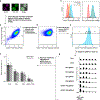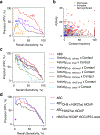Activity-by-contact model of enhancer-promoter regulation from thousands of CRISPR perturbations
- PMID: 31784727
- PMCID: PMC6886585
- DOI: 10.1038/s41588-019-0538-0
Activity-by-contact model of enhancer-promoter regulation from thousands of CRISPR perturbations
Abstract
Enhancer elements in the human genome control how genes are expressed in specific cell types and harbor thousands of genetic variants that influence risk for common diseases1-4. Yet, we still do not know how enhancers regulate specific genes, and we lack general rules to predict enhancer-gene connections across cell types5,6. We developed an experimental approach, CRISPRi-FlowFISH, to perturb enhancers in the genome, and we applied it to test >3,500 potential enhancer-gene connections for 30 genes. We found that a simple activity-by-contact model substantially outperformed previous methods at predicting the complex connections in our CRISPR dataset. This activity-by-contact model allows us to construct genome-wide maps of enhancer-gene connections in a given cell type, on the basis of chromatin state measurements. Together, CRISPRi-FlowFISH and the activity-by-contact model provide a systematic approach to map and predict which enhancers regulate which genes, and will help to interpret the functions of the thousands of disease risk variants in the noncoding genome.
Conflict of interest statement
Competing Interests Statement
E.S.L. serves on the Board of Directors for Codiak BioSciences and Neon Therapeutics, and serves on the Scientific Advisory Board of F-Prime Capital Partners and Third Rock Ventures; he is also affiliated with several non-profit organizations including serving on the Board of Directors of the Innocence Project, Count Me In, and Biden Cancer Initiative, and the Board of Trustees for the Parker Institute for Cancer Immunotherapy. He has served and continues to serve on various federal advisory committees. C.P.F., E.S.L., and J.M.E. are inventors on a patent application (WO2018064208A1) filed by the Broad Institute related to this work.
Figures








Comment in
-
Mapping and predicting gene-enhancer interactions.Nat Genet. 2019 Dec;51(12):1662-1663. doi: 10.1038/s41588-019-0540-6. Nat Genet. 2019. PMID: 31784730 No abstract available.
References
Methods-only references
-
- Gross DS & Garrard WT Nuclease hypersensitive sites in chromatin. Annu Rev Biochem 57, 159–97 (1988). - PubMed
Publication types
MeSH terms
Substances
Grants and funding
LinkOut - more resources
Full Text Sources
Other Literature Sources
Molecular Biology Databases

